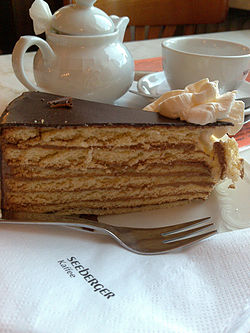Prinzregententorte
Prinzregententorte is a Bavarian cake, which consists of at least six thin layers of sponge cake interlaid with chocolate buttercream. The exterior is covered in a dark chocolate glaze. The Prinzregententorte is very popular in Bavaria, available in cake shops all year round.Origin The cake is named after Prince Regent Luitpold, who was Prince Regent of Bavaria beginning in 1886. Its exact origin remains in dispute; among those claimed as its creators are the prince regent's cook, Johann Rottenhoeffer, the baker Anton Seidl, and the baking firm of Heinrich Georg Erbshauser. [edit]Recipe Typically, the cake consists of very thin layers of sponge cake, each approximately 25 cm in diameter, with chocolate buttercream on each side. Apricot jam may be added to the topmost layer, and the whole cake is covered in dark chocolate. The Free State of Bavaria (German: Freistaat Bayern, pronounced [?f?ata?t ?ba?.?n] ( listen)), is a state of Germany, located in the southeast of Germany. With an area of 70,548 square kilometres (27,200 sq mi), it is the largest state by area, forming almost 20% of the total land area of Germany. Bavaria is Germany's second most populous state (after North Rhine-Westphalia), with 12.5 million inhabitants, more than any of the three sovereign nations on its borders. Bavaria's capital and largest city is Munich, the third largest city in Germany. One of the oldest states of Europe, it was established as a duchy in the mid first millennium. In the 17th century, the Duke of Bavaria became a Prince-elector of the Holy Roman Empire of the German Nation. The Kingdom of Bavaria existed from 1806 to 1918, and Bavaria has since been a free state (republic). Modern Bavaria also includes parts of the historical regions of Franconia, Upper Palatinate and Swabia.Sponge cake is a cake based on flour (usually wheat flour), sugar, and eggs, sometimes leavened with baking powder which has a firm, yet

well aerated structure, similar to a sea sponge. A sponge cake may be produced by either the batter method, or the foam method. Typically the batter method in the U.S. is known as a butter or pound cake while in the U.K. it is known as Madeira cake or Victoria sponge cake. Using the foam method a cake may simply be known as a sponge cake or in the U.K. occasionally whisked sponge, these forms of cake are common in Europe especially in French patisserie. The sponge cake is thought to be one of the first of the non-yeasted cakes, and the earliest recorded sponge cake recipe in English is attested to the 1615 book of English poet and author Gervase Markham entitled; The English Huswife, Containing the Inward and Outward Virtues Which Ought to Be in a Complete Woman.[1] Though it does not appear in Hannah Glasse's The Art of Cookery in the late 18th century, it is found in Lydia Maria Child's The American Frugal Housewife,[2] indicating that sponge cakes had been established at Grenada in the Caribbean, by the early 19th century. Variations on the theme of a cake lifted, partially or wholly, by trapped air in the batter exist in most places where European patisserie has spread, including the French Genoise, the Portuguese pao-de-lo, the Anglo-Jewish "plava"[3] and the possibly ancestral Italian/Sephardic Jewish pan di Spagna ("Spanish bread", from the Ladino pan d'Espana, transferred to the Greek as pandespani and the Bosnian as patispanja).[4][5] Derivatives of the basic sponge cake idea include the American chiffon cake and the Latin American Tres leches cake.[6] The sponge cake is a variation on the so-called pan di Spagna (literally 'bread of Spain'), a cake invented by Giobatta Cabona (a cook from Genoa at the service of the genoese ambassador in Spain, marquis Domenico Pallavicini) on the occasion of a banquet, where he presented a cake of incredible lightness that took its name to honor the Spanish court.